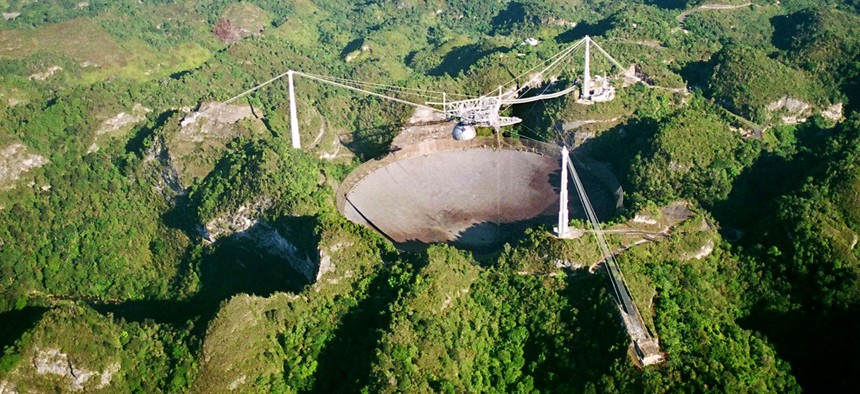Puerto Rico's Massive Telescope Is Still Running on Generators

The world's largest radio telescope is seen from the air in this Wednesday, March 26, 2003 photo at the Arecibo Observatory, Puerto Rico. Tomas van Houtryve/AP File Photo
The Arecibo Observatory is facing months of costly repairs after Hurricane Maria struck in September.
Nearly two months after Hurricane Maria struck Puerto Rico, many residents are still without power and struggling to get access to water, food, and basic services. This week, a failed transmission line knocked out what little of the island’s electrical grid had been restored, temporarily leaving thousands of people in the dark once again.
The recovery from the devastating Category 4 hurricane is expected to be long and costly for all of Puerto Rico, including at the Arecibo Observatory, the world’s second-largest radio telescope, which sits in a mountain range in the island’s northwest.
As the storm approached Puerto Rico in September, several researchers remained at Arecibo to keep watch over the 305-meter-wide dish, taking shelter in concrete buildings with food, water, and fuel for generators. The staff made it through unharmed, and when the worst of Hurricane Maria passed, they found the facility had survived, with some damage. The main dish, while intact, lost some of its reflective panels, and most of a 29-meter-long antenna was destroyed. But it wasn’t as bad as they expected, considering Hurricane Maria’s 155-mile-per-hour winds. “It’s a thing to be thankful for,” Joan Schmelz, the observatory’s deputy director, told Science magazine back then.
The observatory was back up and running on generators a week after the hurricane hit. But as of this week, Arecibo still hasn’t resumed normal operations. The observatory is still running on generator power, according to Suraiya Farukhi, a spokesperson for the Universities Space-Research Association (USRA), one of Arecibo’s operators.
Right now, the radio telescope is locked in a single direction, a configuration meant to save energy, Science reports. Maneuvers to point the telescope in different spots would double fuel consumption, and fuel is in high demand on the island.
Arecibo has observed the skies since the 1960s, searching for stars, exoplanets, asteroids, and potential signals from extraterrestrial civilizations. The iconic observatory has served as a research base for, among others, Jill Tarter, the cofounder of the ET-searching SETI Institute; Frank Drake, the creator of the famous equation for estimating the number of potential alien civilizations; and the late Carl Sagan, perhaps the best-known advocate for space exploration. In 1993, astronomers won a Nobel Prize in physics for discovering of a new kind of pulsar—a fast-rotating star that emits beams of light—using the Arecibo dish. The observatory employed the fictional scientist Ellie Arroway in 1997’s Contact, a character inspired by Tarter.
Some worry the expensive repairs necessary to return Arecibo to normal may influence the National Science Foundation’s thinking on the observatory’s future. NSF, which owns Arecibo, has long considered reducing its annual contributions to the facility and even passing off management to another party. The NSF spends $8.3 million on operations each year, with NASA providing $3.6 million, according to Science. The National Science Board, which governs the NSF, is expected to publicly announce plans for Arecibo’s future next week.
One of the research facilities at Arecibo, the Planetary Habitability Laboratory, which is managed by the University of Puerto Rico, said the lab sustained “extensive damage to its walls, floor, computers, materials, and furniture” and is asking for help in rebuilding. “The lab is in the process now of a complete rebuild that might take a few weeks or even months,” a post on the laboratory’s website said Thursday. “Most of the structural damage to the lab should be covered by FEMA, the insurance, and the university. However, about $14,000 of damage to our furniture, computers, and scientific materials might not be covered.”
The scientists who work at Arecibo face their own personal recoveries. USRA said this week that it had shipped from Maryland to Puerto Rico 20 portable generators and donated them to USRA employees who badly need electricity in their homes.
Several employees who hunkered down at Arecibo during the hurricane, tweeting various updates—from the state of the observatory to the kinds of snacks they’d brought with them—continue to share news on social media. Their messages highlight the incredibly slow pace of recovery. “And, lo! Our water supply was restored!” Robert Minchin, head of radio astronomy at Arecibo, tweeted Wednesday, seven weeks after the hurricane arrived. “This morning I have water, power, and broadband at home!” he wrote a day later.
NEXT STORY: An important new guide to agile






